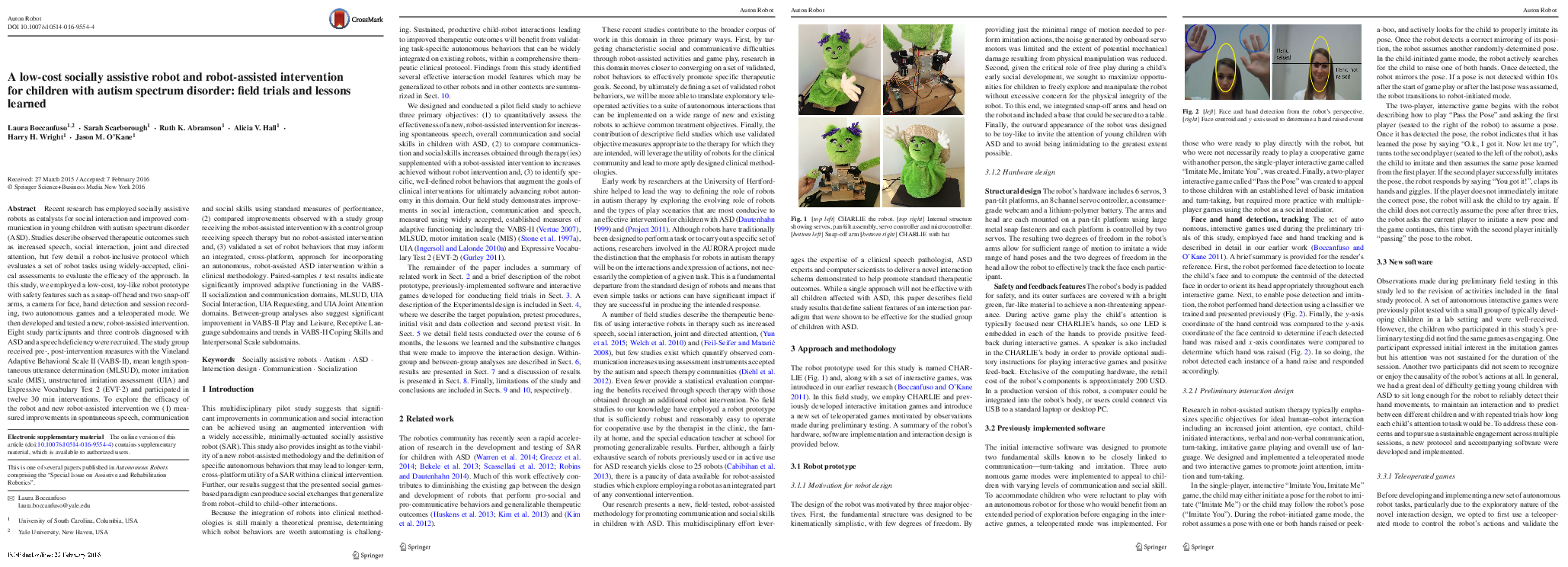 Laura Boccanfuso and Sarah Scarborough and Ruth K. Abramson and Alicia V. Hall and Harry H. Wright and Jason M. O'Kane
Laura Boccanfuso and Sarah Scarborough and Ruth K. Abramson and Alicia V. Hall and Harry H. Wright and Jason M. O'KaneAbstract Recent research has employed socially assistive robots (SAR) as catalysts for social interaction and improved communication in young children with autism spectrum disorder (ASD). Studies describe observed therapeutic outcomes such as increased speech, social interaction, joint and directed attention, but few detail a robot-inclusive protocol which evaluates a set of robot tasks using widely-accepted, clinical assessments to evaluate the efficacy of the approach. In this study, we employed a low-cost, toy-like robot prototype with safety features such as a snap-off head and two snap-off arms, a camera for face, hand detection and session recording, two autonomous games and a teleoperated mode. We then developed and tested a new, robot-assisted intervention. Eight study participants and three controls diagnosed with ASD and a speech deficiency were recruited. The study group received pre- and post-intervention measures with the Vineland Adaptive Behavioral Scale II (VABS-II), Mean Length Spontaneous Utterance Determination (ML-SUD), Motor Imitation Scale, Unstructured Imitation Assessment (UIA) and Expressive Vocabulary Test 2 (EVT2) and participated in twelve 30-minute interventions. To explore the efficacy of the robot and new robot-assisted intervention we (1) measured improvements in spontaneous speech, communication and social skills using standard measures of performance, (2) compared improvements observed with a study group receiving the robot-assisted intervention with a control group receiving speech therapy but no robot-assisted intervention and, (3) validated a set of robot behaviors that may inform an integrated, cross-platform, approach for incorporating an autonomous, robot-assisted ASD intervention within a clinical methodology. Paired-samples t-test results indicate improved adaptive functioning in the VABS-II Socialization and Communication Domains, ML-SUD, UIA Social Interaction, UIA Requesting, and UIA Joint Attention domains. Between-group analyses also showed significant improvement in VABS-II Play and Leisure, Reeptive Language subdomains and trends in VABS-II Coping Skills and Interpersonal Scale subdomains.
@article{BocSca+16,
author = {Laura Boccanfuso and Sarah Scarborough and Ruth K. Abramson
and Alicia V. Hall and Harry H. Wright and Jason
M. O'Kane},
journal = {Autonomous Robots},
month = {March},
number = {3},
pages = {637--655},
title = {A low-cost socially assistive robot and robot-assisted
intervention for children with autism spectrum
disorder: Field trials and lessons learned},
volume = {41},
year = {2017}
}
